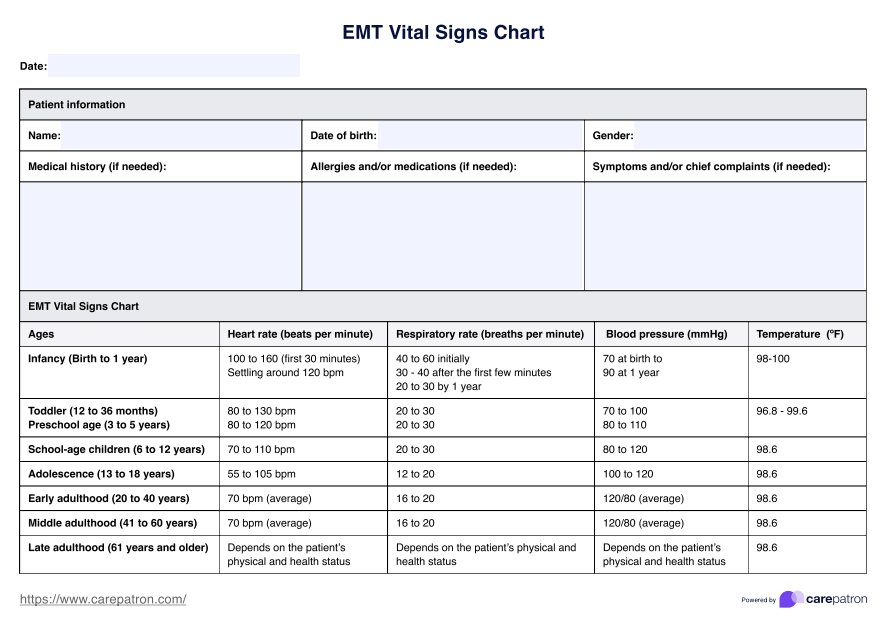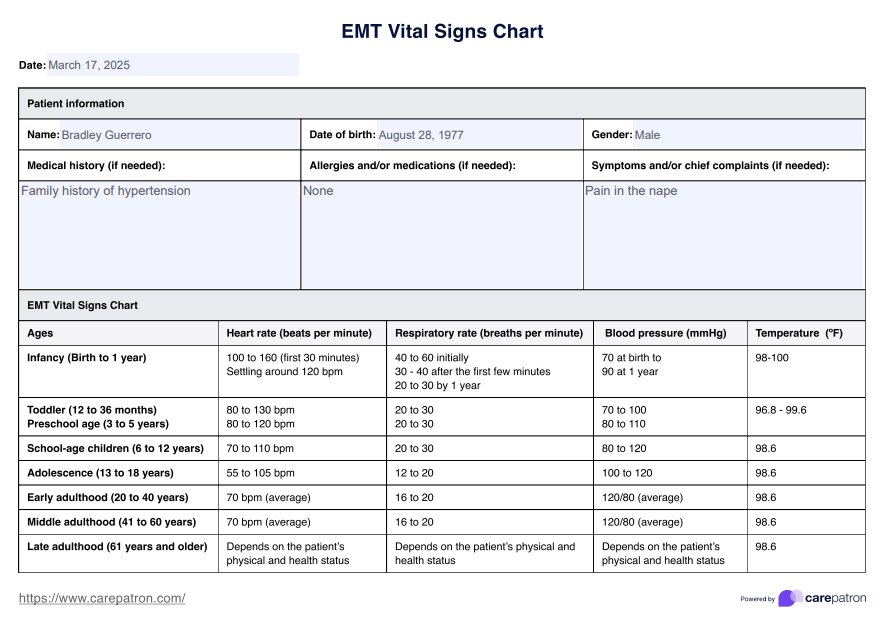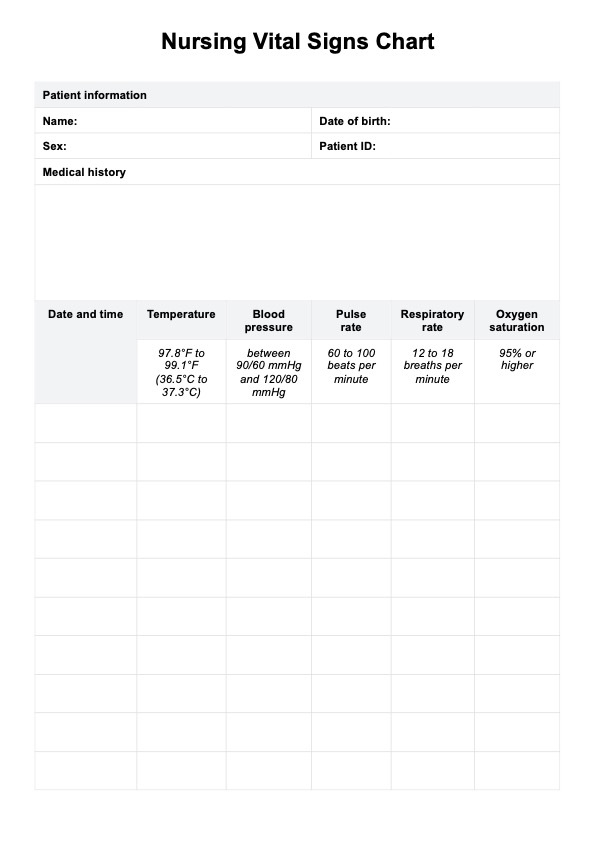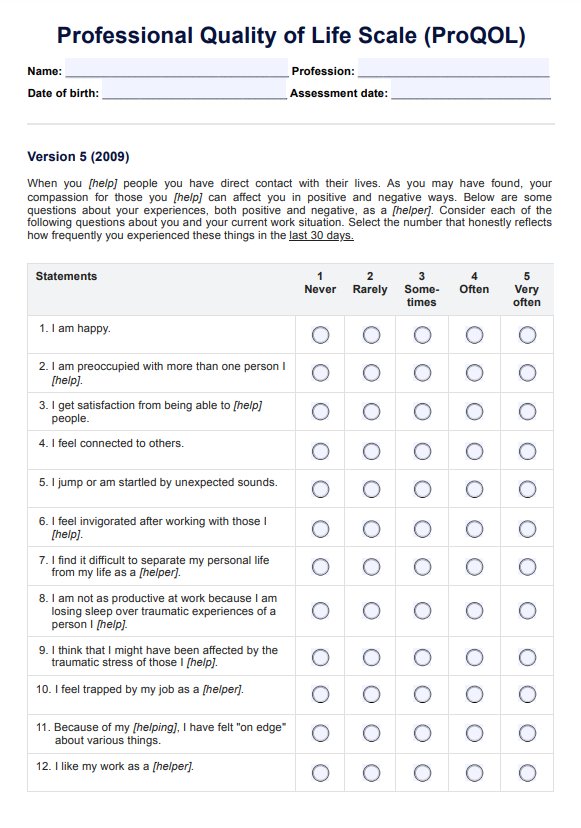EMT Vital Signs Chart
Quickly refer to this EMT Vital Signs Chart when evaluating your patients during emergencies. Get this resource for free!


What is an EMT Vital Signs Chart?
An Emergency Medical Technician (EMT) vital signs chart is an invaluable reference guide utilized in emergency medical services. It is derived from the National Emergency Medical Services Educational Standards (NEMSES) and specifically outlined in the Emergency Medical Technician Instructional Guidelines. This comprehensive chart is a crucial tool for EMTs preparing for the National Registry of Emergency Medical Technicians (NREMT) exam. It can also be used to record results after going into the field.
The chart encompasses a spectrum of vital signs essential for assessing a patient's physiological status during emergencies. These vital signs include heart rate, respiratory rate, blood pressure, and temperature. More comprehensive charts may incorporate supplementary clinical exam findings like capillary refill time, which is assessed in seconds.
It is imperative to note that the specifics of vital signs and the ranges of the typical vital signs are contingent upon variables such as age, gender, and overall health condition. Therefore, you must consistently consult authoritative sources' most current and relevant guidelines when utilizing an EMT Vital Signs Chart. This meticulous adherence ensures the delivery of accurate and effective emergency medical care in diverse clinical scenarios.
EMT Vital Signs Chart Template
EMT Vital Signs Chart Example
How does the EMT Vital Signs Chart work?
Though our EMT vitals chart is pretty straightforward, here are step-by-step instructions on how to utilize the template to make the most out of this resource:
Step 1: Secure a template copy
Retrieve a helpful resource, like the EMT vital signs cheat sheet, effortlessly during review or recording robust results after emergencies. You can achieve this task by selecting the "Download Template" or "Use Template" button. Alternatively, you can locate the chart in Carepatron's template library on the app or website by searching "EMT Vital Signs Chart."
Step 2: Enter essential patient details
If you intend to utilize the EMT normal vital signs chart as an educational tool for studying or reviewing, it is advisable to input crucial patient information while measuring blood pressure, checking pulse pressure with a pulse oximeter, and measuring the body's core temperature with a thermometer.
Step 3: Give the template to the referring physician
For documentation purposes or if you think the referring physician will benefit from having a record of the vital signs you took in the field or on the trip to the hospital, you may give your completed template to the referring physician.
Step 4: Secure the template copy
Whoever held the completed template last must ensure the template is protected and access is limited to relevant parties exclusively. For digital copies, we recommend using Carepatron, a software compliant with global security standards, to safeguard all electronic patient records.
When would you use this EMT Vital Signs Chart?
An EMT Vital Signs Chart is a critical tool in various situations, each pivotal in ensuring timely and effective emergency medical care.
Patient assessment
Firstly, during patient assessment in emergencies, the chart becomes instrumental. It enables EMTs to swiftly gauge the severity of a patient's condition by analyzing vital signs, facilitating quick decision-making on necessary interventions.
Monitoring patients
Furthermore, the EMT monitors patients' vital signs throughout transport or treatment. Continuous reference to the chart allows EMTs to track changes in vital signs, providing real-time insights into the patient's evolving condition. Recognizing significant deviations from baseline values is essential as it can signify alterations in the patient's health status, prompting immediate adjustments to the treatment plan.
Communication tool
In addition, the chart serves as a communication tool when EMTs interact with other healthcare professionals. EMTs can summarize the patient's vital signs and write them on a pre-made clinical note document like the template provided. This consequently fosters clear and effective interdisciplinary communication.
Education and training
Moreover, the EMT vital signs sheet extends its utility to education and training contexts. Aspiring EMTs preparing for certification exams, such as the NREMT, utilize the chart as a study aid. It helps them internalize the typical ranges of vital signs, ensuring that practitioners-in-training possess the foundational knowledge necessary for delivering competent emergency medical care.
It is imperative to note that applying the vital signs chart demands adherence to critical sign parameters' specific and dynamic nature, which can vary based on age, sex, and overall health condition. Thus, EMTs must consistently refer to the most recent and pertinent guidelines to ensure accuracy and relevance in using the vital signs chart across diverse emergency scenarios.
Baseline values
The values in the chart convey crucial information regarding various physiological parameters, each offering insights into the human body's overall health and functioning.
Heart rate
Firstly, the heart rate, denoting the number of heartbeats per minute, is a crucial indicator of cardiovascular function and blood circulation. In adults, the normal range falls between 60 and 100 beats per minute, with variations for children and infants based on their respective age groups.
Respiratory rate
Similarly, the respiratory rate, indicating the number of breaths taken per minute, reflects the efficiency of the respiratory system and the exchange of oxygen. The accepted range for adults is 12-20 breaths per minute, while children and infants exhibit varying normal ranges according to their age.
Blood pressure
Blood pressure results highlight the force of blood exertion on arterial walls, providing insights into cardiovascular health and perfusion. The normal range in adults is typically 120/80 mmHg (systolic/diastolic), with variations in children and infants based on age, height, and weight.
Temperature
Temperature results, representing the body's degree of heat, are essential for assessing thermoregulation and detecting possible infections. The normal temperature range for adults is 36.5-37.5°C (97.7-99.5°F), while variations exist for children and infants based on age and the measurement method.
Understanding these vital sign results enables EMTs to evaluate a patient's physiological state during emergencies promptly, facilitating informed decisions and appropriate interventions tailored to the individual's specific needs and conditions.
Commonly asked questions
Paramedics and certified or in-training emergency medical technicians typically use an EMT Vital Signs Chart.
The EMT Vital Signs Chart is used to assess and monitor patients during emergencies on their way to the hospital. They may also be used during the EMT's training period.
The EMT Vital Signs Chart can be used in multiple ways. It can be used as a reference, guide, educational resource, and document where one can record the patient's vital signs.















































































































